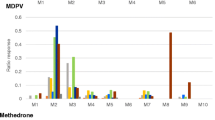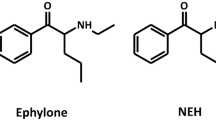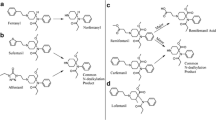Summary
The in vitro metabolism of mifentidine and several of its metabolites was studied using hepatic microsomes from seven animal species. The effects of potential enzyme inducers, inhibitors and activators were also studied. Mifentidine metabolites identified and characterised were: 4-imidazolylphenylamine (amine), 4-imidazolylphenyl-formamide (formamide), the urea derivative of mifentidine (urea) and the imidazole-hydroxylated derivative of the amine (i-OH-amine), along with three unidentified metabolites, M1, M2 and M3. Evidence for the presence of the amine, formamide, urea and i-OH-amine was obtained by comparison with authentic reference compounds: (i) HPLC retention times; (ii) UV spectra; and (iii) MS spectra of metabolites. The postulated intermediates are: carbinolimine (for formamide, amine, i-OH-amine and urea formation); formamide (for amine and i-OH-amine formation); amine (for i-OH-amine formation), and nitrone (for urea formation). One ‘metabonate’ of mifentidine was also identified, namely the nitro analogue of the amine. A possible prerequisite for the formation of this nitro is the corresponding hydroxylamine or nitroso compound. Cytochromes P450I and P450II were shown to be involved in the in vitro microsomal biotransformation of mifentidine, but the involvement of the flavin monooxygenase system was not proven.
Similar content being viewed by others
References
Bertaccini G., Poli E., Coruzzi G. (1984): Action of the new H2-antagonist DA4577, on different in vitro and in vivo preparations. Agents Actions, 14, 510–515.
Donetti A., Cereda E.M., Bellora E. et al. (1984): (Imidazolylphenyl) formamidines. A structurally novel class of potent histamine H2-receptor antagonists. J. Med. Chem., 27, 380–386.
Del Soldato P., Ghjiorzi A., Cereda E., Donetti A. (1985): Cimetidine, ranitidine and mifentidine in specific gastric and duodenal ulcer models. Pharmacology, 30, 45–51.
Scarpignato C., Tangwa M., Tramacere R., Del Saldato P. (1986): The effect of new H2-receptor antagonist mifentidine on gastric secretion, gastric emptying and experimental gastric and duodenal ulcers in the rat: comparison with cimetidine and ranitidine. Digestion, 33, 7–16.
Bianchi Porro G., Lazzaroni M., Imbimbo B.P., Sangaletti O., Ghirardosi C., Daniotti A. (1987): Action of mifentidine on the secretory response to sham feeding and pentagastrin and on serum gastrin in duodenal ulcer patients. Eur. J. Clin. Pharmacol., 32, 555–558.
Kajbaf M., Lamb J., Naylor S., Pattichis K., Gorrod J.W. (1991) Identification of metabolites derived from the H2-receptor antagonist mifentidine using tandem mass spectrometry. Anal. Chim. Acta, 247, 151–159.
Pattichis K. (1991): The in vitro metabolic fate of mifentidine, a novel histamine H2-receptor antagonist. PhD Thesis, University of London, UK.
Pattichis K., Kajbaf M., Gorrod J.W. (1991): The in vitro metabolism of mifentidine and two of its derivatives by different species. Prog. Pharmacol. Clin. Pharmacol., 8, 31–40.
Kajbaf M., Jahanshahi M., Pattichis K., Gorrod J.W., Naylor S. (1992): Rapid and efficient purification of cimetropium bromide and mifentidine drug metabolite mixtures derived from microsomal incubates for analysis by mass spectrometry. J. Chromatogr., 575, 75–85.
Pattichis K., Louca L.L., Kajbaf M., Gorrod J.W. (1993): Mifentidine, a formamidine, is metabolised to a urea; a new metabolic pathway. Med. Sci. Res., 21, 747–748.
Schenkman J.B., Cinti D.L. (1978): Preparation of microsomes with calcium. Methods Enzymol., 52, 83–89.
Lam S.P., Barlow D.J., Gorrod J.W. (1989): Conformational analysis of 9-substituted adenines in relation to their microsomal N-oxidation. J. Pharm. Pharmacol., 41, 373–378.
Anders M.W., Mannering G.J. (1966): Inhibition of drug metabolism. 1. Kinetics of the inhibition of N-demethylation of ethylmorphine by 2-diethylaminoethyl-2,2-diphenylvalerate HCl (SKF 525-A) and related compounds. Mol. Pharmacol., 2, 319–327.
Buening M.K., Franklin M.R. (1976): SKF 525-A inhibition, induction and 452 nm complex formation. Drug Metab. Dispos., 4, 244–255.
Ziegler D., Poulsen L.L., McKee E.M. (1971): Interaction of primary amines with a mixed-function amine oxidase isolated from pig liver microsomes. Xenobiotica, 1, 523–531.
Gorrod J.W. (1978): On the multiplicity of N-oxidase systems. In: Singer T.P., Ondarzo R.N. (eds) Developments in Biochemistry, vol. 1 Mechanism of oxidising enzymes. New York: North-Holland/elsevier, 189–197.
Poulsen L.L., Ziegler D.M. (1979): The liver microsomal FAD-containing monooxygenase. J. Biol. Chem. 254, 6449–6455.
Canas-Rodriguez A. (1966): Preliminary studies on the metabolism of 2-guanidinomethyl-1:4-benzodioxan sulphate (Guanoxan). Experientia, 22, 472–473.
Ziegler D.M., Mitchell C.H., Jollow D. (1969): The properties of a purified hepatic microsomal mixed function amine oxidase. In: Gillette J.R., Conney A.H., Cosmides G.I., Estabrook R.W., Fouts J.R., Mannering G.J. (Eds) Microsomes and Drug Oxidations. New York: Academic Press, 173–188.
Naylor S., Tomlinson A.J., Benson L.M., Gorrod J.W. (1994): Capillary electrophoresis and capillary electrophoresis-mass spectrometry in drug metabolite analysis. Eur. J. Drug Metab. Pharmacokinet., 13, 235–240.
Cowan D.A. (1978): Mass spectrometry as an aid to the identification of N-oxygenated organic molecules. In: Gorrod J.W. (Ed.) Biological Oxidation of Nitrogen. Amsterdam: Elsevier/North Holland, 263–268.
Author information
Authors and Affiliations
Rights and permissions
About this article
Cite this article
Pattichis, K., Kajbaf, M. & Gorrod, J.W. In vitro studies on the metabolic fate of mifentidine, a novel histamine H2-receptor antagonist. European Journal of Drug Metabolism and Pharmacokinetics 22, 155–164 (1997). https://doi.org/10.1007/BF03189800
Received:
Issue Date:
DOI: https://doi.org/10.1007/BF03189800




